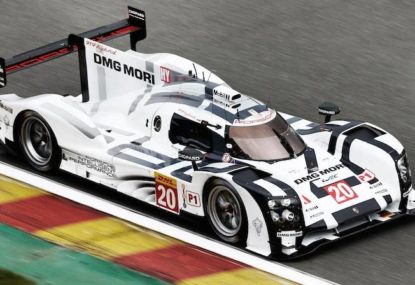Roar Guru

KCMG held a slender championship lead over G-Drive in the LMP2 World Endurance Championship [WEC] standings heading into the six Hours of Fuji. While it’s fair to say that neither team gave any quarter that day, there was definitely an air of ‘take the opposition out’ at all costs vibe from the G-Drive camp.
This reached its crescendo when G-Drive pilot Gustavo Yacaman punted KCMG’s Richard Bradley off track at high speed, slamming the Brit into the barriers and out of contention.
Sam Bird, Julien Canal and Roman Rusinov eventually claimed victory after also clashing with the rival KCMG ORECA-Nissan 05 during the final hour. Rusinov was hounding the rear of KCMG driver Richard Bradley for the class lead when he ran into the back of the ORECA through the corner before pit-entry.
Bradley was subsequently forced to pit but then found himself tangled with the second G-Drive Ligier of Gustavo Yacaman as he tried to take third place and crashed out of the race.
“In the end, Bradley was very aggressive in his way of defending,” said Yacaman after the accident. “Before the final incident I had a couple of contacts with him. I went much faster than him, and then he changed, defended, made movements and it was very unfortunate.”
Intriguingly, if you look at the footage closely, it is Yacaman who darts around and changes line, creating the illusion that Bradley moves off-line, yet in relation to the track he keeps his natural course.
Incomprehensibly, it was initially Bradley who was found to be in the wrong in post-race deliberations; with initial ‘evidence’ claiming the Brit had braked ’37 metres’ earlier than normal, and therefore prompted the collision.
What is more alarming is that this decision was overturned upon the presentation of telemetry from KCMG, detailing that Bradley was at 100 per cent throttle at the time of the impact. Two questions here. If no such evidence was available, how did stewards come to their initial conclusion and secondly, why wasn’t this decision delayed until all the evidence was presented?
To understand the underlying politics simmering below the KCMG / G-Drive battle, we have to go back to last year in the largely unnoticed Asian Le Mans series when Oak Racing [G-Drive’s French constructors] were engaged in a heated championship battle with Asian-based team KCMG.
When expected to come in for a scheduled pit-stop, there were many raised eyebrows when the Oak car kept turning in laps – way more than could be reasonably expected given the homologated fuel tank size. Yet the French squad were able to run considerably longer and consequently create a sizeable advantage for themselves when the flag dropped.
Sensing something was amiss, KCMG lodged a protest and when scrutineered under the supervision of one of Nissan’s engineers, the car was still able to run under its own power even after the tank was drained.
Even the layman motorsport fan could see something wasn’t exactly kosher, but the matter was swept under the carpet and the Oak/KCMG relationship began to fester.
Fast-forward to the Fuji incident last weekend. One suspects the weight of support behind Bradley on Twitter [from a large number of respected drivers] had a hand in overturning the decision, or even reviewing all the evidence available. But if this is what it takes to force a begrudging retraction, then I fear certain factions aren’t taking driver safety seriously – unfathomable given the tragedy endured by the sport during the last few months.
What message are we sending to young drivers? Get on the right side of influential factions and you’ll get away with murder? Regrettably, in a sport as dangerous as this, the metaphor becomes literal. WEC has been a shining light in fading shadow of Formula One. The last thing it needs is back room favouritism dragging it down.
As my youthful optimism gives way to weary cynicism, I’ve come to accept this the way of the world. That the freemason-like machinations behind the sport will go largely unnoticed, but when it runs the risk of endangering lives on the sporting field, it’s time to call time out.